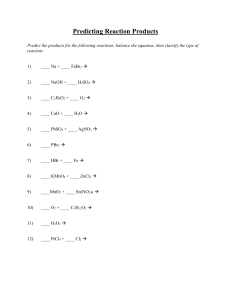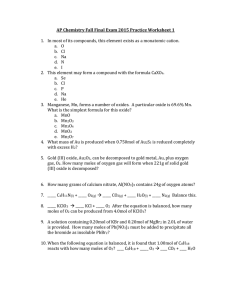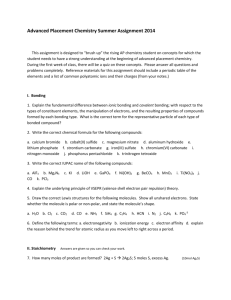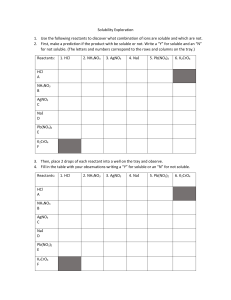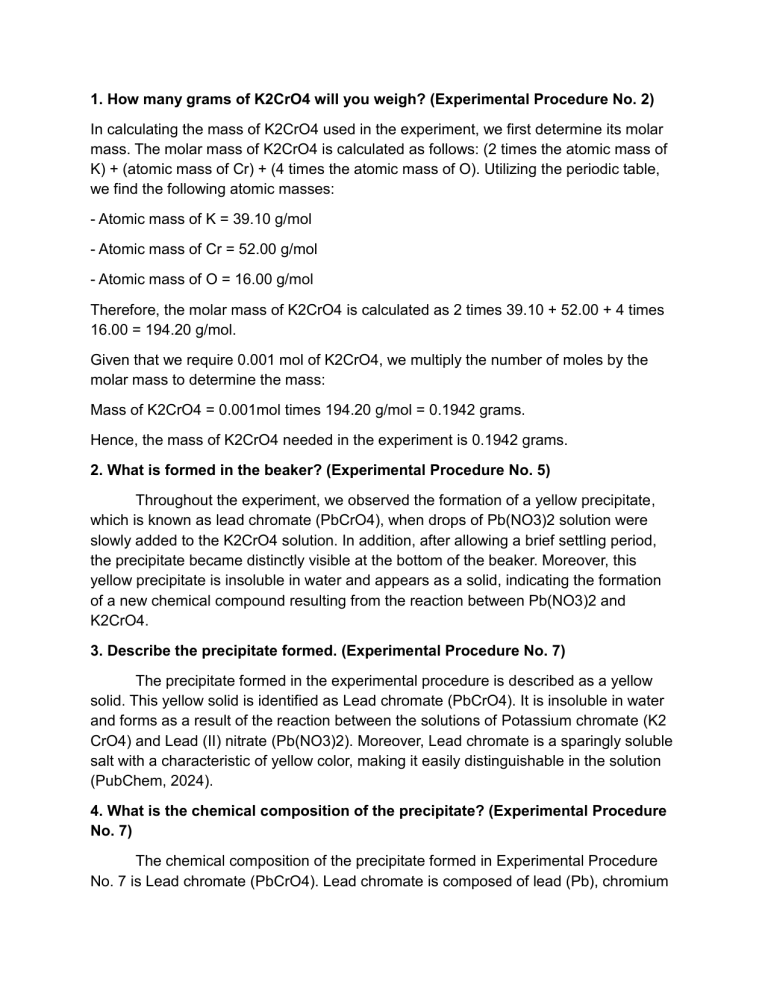
1. How many grams of K2CrO4 will you weigh? (Experimental Procedure No. 2) In calculating the mass of K2CrO4 used in the experiment, we first determine its molar mass. The molar mass of K2CrO4 is calculated as follows: (2 times the atomic mass of K) + (atomic mass of Cr) + (4 times the atomic mass of O). Utilizing the periodic table, we find the following atomic masses: - Atomic mass of K = 39.10 g/mol - Atomic mass of Cr = 52.00 g/mol - Atomic mass of O = 16.00 g/mol Therefore, the molar mass of K2CrO4 is calculated as 2 times 39.10 + 52.00 + 4 times 16.00 = 194.20 g/mol. Given that we require 0.001 mol of K2CrO4, we multiply the number of moles by the molar mass to determine the mass: Mass of K2CrO4 = 0.001mol times 194.20 g/mol = 0.1942 grams. Hence, the mass of K2CrO4 needed in the experiment is 0.1942 grams. 2. What is formed in the beaker? (Experimental Procedure No. 5) Throughout the experiment, we observed the formation of a yellow precipitate, which is known as lead chromate (PbCrO4), when drops of Pb(NO3)2 solution were slowly added to the K2CrO4 solution. In addition, after allowing a brief settling period, the precipitate became distinctly visible at the bottom of the beaker. Moreover, this yellow precipitate is insoluble in water and appears as a solid, indicating the formation of a new chemical compound resulting from the reaction between Pb(NO3)2 and K2CrO4. 3. Describe the precipitate formed. (Experimental Procedure No. 7) The precipitate formed in the experimental procedure is described as a yellow solid. This yellow solid is identified as Lead chromate (PbCrO4). It is insoluble in water and forms as a result of the reaction between the solutions of Potassium chromate (K2 CrO4) and Lead (II) nitrate (Pb(NO3)2). Moreover, Lead chromate is a sparingly soluble salt with a characteristic of yellow color, making it easily distinguishable in the solution (PubChem, 2024). 4. What is the chemical composition of the precipitate? (Experimental Procedure No. 7) The chemical composition of the precipitate formed in Experimental Procedure No. 7 is Lead chromate (PbCrO4). Lead chromate is composed of lead (Pb), chromium (Cr), and oxygen (O) ions. In the chemical formula PbCrO4, there is one lead atom (Pb), one chromium atom (Cr), and four oxygen atoms (O). This compound is commonly known as Lead(II) chromate or chrome yellow and is characterized by its bright yellow color. 5. What is being removed when washing the precipitate? (Experimental Procedure No. 10) During the washing of the precipitate in Experimental Procedure No. 10, soluble impurities and excess reagents are being removed. These impurities can include any soluble substances such as dust and dirt that are not part of the desired precipitate and may have been introduced during the reaction or subsequent steps during the experiment. Furthermore, excess reagents refer to reactants that were not consumed during the reaction and remained in the solution (Libretexts, 2015). Removing these impurities and excess reagents ensures the purity of the precipitate, which is essential for accurate analysis and interpretation of experimental results. 6. What is the purpose of drying? (Experimental Procedure No. 13) The purpose of drying, as outlined in Experimental Procedure No. 13, is to remove any residual moisture from the precipitate. This step ensures that the precipitate is completely dry before weighing, allowing for an accurate determination of its mass. By eliminating moisture, the drying process helps prevent any potential errors that could arise from the presence of water, thereby improving the precision of the experimental results. 7. Based on the curve obtained, how does the number of moles of precipitate vary with the number of moles of K2CrO4? In trials 1 through 4, the measured amounts of precipitate were 0.0008, 0.0021, 0.0029, and 0.0031 moles, respectively. Through careful examination of the obtained curve or data, one can discern the relationship between the quantity of precipitate and the amount of K2CrO4. This correlation typically aligns with the stoichiometry dictated by the chemical reaction between K2CrO4 and Pb(NO3)2, resulting in the formation of PbCrO4. In essence, the quantity of precipitate shows a discernible increase corresponding to the rising amount of K2CrO4, while the quantity of Pb(NO3)2 remains constant. 8. How does the number of moles of precipitate vary with the number of moles of Pb(NO3)2 ? The quantity of precipitate correlates directly with the quantity of moles of Pb(NO3)2, as dictated by the stoichiometry of the balanced chemical equation. In the balanced equation representing the reaction between K2CrO4 and Pb(NO3)2, the stoichiometric coefficient of Pb(NO3)2 is 1. This signifies that for each mole of Pb(NO3)2 reacted, one mole of precipitate PbCrO4 is generated. Consequently, as the number of moles of Pb(NO3)2 increases, the quantity of precipitate formed also increases proportionally. Conversely, if the number of moles of Pb(NO3)2 decreases, the quantity of precipitate formed will likewise decrease accordingly, provided that K2CrO4 is not the limiting reagent. 9. In which cases (0.001, 0.002, 0.003, 0.004) were the amounts of K2CrO4 added to 0.003 mole Pb(NO3)2? To ascertain whether the amounts of K2CrO4 added to 0.003 mole Pb(NO3)2 were insufficient, just sufficient, or in excess, we compared the stoichiometric ratio of K2CrO4 to Pb(NO3)2 in the balanced chemical equation. The balanced chemical equation for the reaction between K2CrO4 and Pb(NO3)2 is: 2K2CrO4+Pb(NO3)2→PbCrO4+2KNO3 According to the stoichiometry of this equation: For every 2 moles of K2CrO4 reacted, 1 mole of Pb(NO3)2 is required. This means the molar ratio of K2CrO4 to Pb(NO3)2 is 2:1. a. insufficient 0.001 moles K2CrO4 were added to 0.003 moles of Pb(NO3)2. In this specific scenario, only 0.001 moles of K2CrO4 are provided, which is less than the stoichiometric amount required to react with the 0.003 moles of Pb(NO3)2 available. As a result, the limited quantity of K2CrO4 prevents all 0.003 moles of Pb(NO3)2 from reacting completely, making K2CrO4 the limiting reagent and insufficient. b. just sufficient 0.002 moles of K2CrO4 were added to 0.003 moles of Pb(NO3)2. Given 0.003 moles of Pb(NO3)2, we calculate the theoretical amount of K2CrO4required for complete reaction using the stoichiometric ratio 2:1. Thus, 0.003 moles of Pb(NO3)2 needs .0015 moles of K2CrO4 for stoichiometric balance. When 0.002 moles of K2CrO4 are added, this exceeds the stoichiometric requirement of 0.0015 moles. However, 0.002 moles of K2CrO4 remain less than twice the moles of Pb(NO3)2, confirming K2CrO4 is not in excess. Thus, in this case, reactant amounts align precisely with the stoichiometric ratio for complete reaction without any excess of K2CrO4. C. in excess 0.003 moles of K2CrO4 were added to 0.003 moles of Pb(NO3)2. 0.004 moles of K2CrO4 were added to 0.003 moles of Pb(NO3)2. When 0.0030 moles of Pb(NO3)2 are provided, the stoichiometric requirement for K2CrO4 is only half of that, which is 0.0015 moles. Therefore, 0.003 moles of K2 CrO4 exceeds the stoichiometric amount needed to react with 0.003 moles of Pb(NO3)2 , making K2CrO4 the excess reagent. Similarly, when 0.004 moles of K2CrO4 are added, it further surpasses the stoichiometric requirement, maintaining its status as the excess reagent in the reaction. 10. What is meant by "limiting reagent"? The "limiting reagent" in a chemical reaction is the reactant that is completely consumed first, thus limiting the amount of product that can be formed. It determines the maximum amount of product that can be obtained in the reaction. Once the limiting reagent is used up, the reaction can no longer proceed to produce additional product, even if there are other reactants remaining. The concept of the limiting reagent is crucial in stoichiometry because it allows chemists to predict the maximum yield of a reaction and to determine the amounts of reactants needed for complete reaction. 11. In each case, which is the limiting reagent? Justify your answer? 1. 0.001 moles of K2CrO4 added to 0.003 moles of Pb(NO3)2: When 0.001 moles of K2CrO4 are added to 0.003 moles of Pb(NO3)2, K2CrO4 becomes the limiting reagent. This occurs because the amount of K2CrO4 is insufficient to react completely with the 0.003 moles of Pb(NO3)2 available, as dictated by the stoichiometric ratio of 2:1 between K2CrO4 and Pb(NO3)2. Therefore, K2CrO4 limits the extent of the reaction due to its limited quantity. 2. 0.002 moles of K2CrO4 added to 0.003 moles of Pb(NO3)2: When 0.002 moles of K2CrO4 are introduced to 0.003 moles of Pb(NO3)2 , neither K2CrO4 nor Pb(NO3)2 acts as the limiting reagent. While 0.002 moles of K2CrO4 exceed this requirement, they are still less than twice the moles of Pb(NO3)2 provided. Consequently, both reactants align perfectly with the stoichiometric ratio, indicating neither is in excess nor limiting. Hence, in this specific scenario, there is no limiting reagent. 3. 0.003 moles of K2CrO4 added to 0.003 moles of Pb(NO3)2: When 0.003 moles of K2CrO4 are introduced to 0.003 moles of Pb(NO3)2 , Pb(NO3)2 acts as the limiting reagent. Given the presence of0.003 moles of Pb(NO3)2, 0.0015 moles of K2CrO4 would be required for full reaction based on the stoichiometry. However, as only 0.003 moles of K2 CrO4 are provided, this amount precisely aligns with the stoichiometric requirement. Consequently, all 0.003 moles of Pb(NO3)2 can be consumed in the reaction. Thus, Pb(NO3)2 is fully consumed before all of the K2CrO4 is utilized, establishing it as the limiting reagent. 4. 0.004 moles of K2CrO4 added to 0.003 moles of Pb(NO3)2: When 0.004 moles of K2CrO4 are added to 0.003 moles of Pb(NO3)2, Pb(NO3)2 remains the limiting reagent. When 0.004 moles of K2CrO4 are added, this exceeds the stoichiometric requirement. Nevertheless, 0.003 moles of Pb(NO3)2 limit the amount of K2CrO4 that can react. As a result, Pb(NO3)2 is the limiting reagent because it is fully consumed before all of the K2CrO4 can react. 12. What is the mole ratio whereby Pb(NO3)2 and K2CrO4 react completely to form lead chromate PbCrO4? The balanced chemical equation for the reaction: 2K2CrO4+Pb(NO3)2→PbCrO4+2KNO3 From the balanced equation, we see that the coefficients in front of Pb(NO3)2 and K2 CrO4 are 1 and 2 respectively. Therefore, the mole ratio between Pb(NO3)2 and K2 CrO4 is 1:2. This indicates that for every 1 mole of Pb(NO3)2Pb(NO3)2 reacted, 2 moles of K2CrO4 are required to completely react and form lead chromate PbCrO4. 13. Write the balanced equation for the reaction. The balanced equation for the reaction between K2CrO4 and Pb(NO3)2, forming lead chromate PbCrO4 and potassium nitrate KNO3, is as follows: 2K2CrO4+Pb(NO3)2→PbCrO4+2KNO3 This equation ensures that the number of atoms of each element is the same on both sides of the equation, indicating a balanced chemical reaction. References: Libretexts. (2015, May 5). Excess and Limiting Reagents. Chemistry LibreTexts. https://chem.libretexts.org/Bookshelves/Inorganic_Chemistry/Supplemental_Modules_a nd_Websites_(Inorganic_Chemistry)/Chemical_Reactions/Stoichiometry/Excess_and_Li miting_Reagents#:~:text=In%20a%20chemical%20reaction%2C%20reactants PubChem. (2024, March 23). Lead chromate. Pubchem.ncbi.nlm.nih.gov. https://pubchem.ncbi.nlm.nih.gov/compound/Lead-chromate
